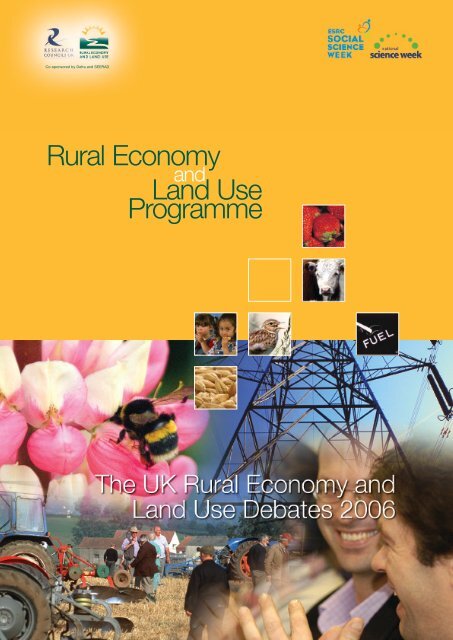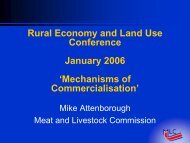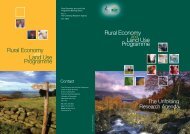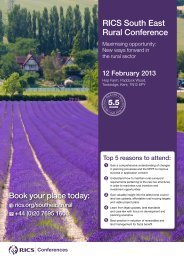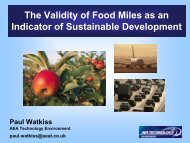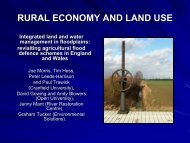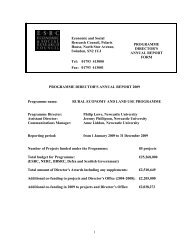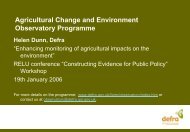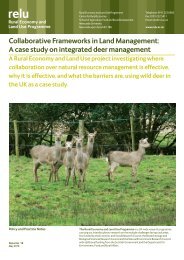Download pdf - Rural Economy and Land Use Programme
Download pdf - Rural Economy and Land Use Programme
Download pdf - Rural Economy and Land Use Programme
Create successful ePaper yourself
Turn your PDF publications into a flip-book with our unique Google optimized e-Paper software.
Co-sponsored by Defra <strong>and</strong> SEERAD<br />
<strong>Rural</strong> <strong>Economy</strong><br />
<strong>and</strong><br />
L<strong>and</strong> <strong>Use</strong><br />
<strong>Programme</strong>
The UK <strong>Rural</strong> <strong>Economy</strong> <strong>and</strong><br />
L<strong>and</strong> <strong>Use</strong> Debates 2006<br />
Foreword<br />
Each year the Economic <strong>and</strong> Social Research<br />
Council stages the ESRC Social Science<br />
Week to celebrate developments in the<br />
social sciences. In 2006 this major event<br />
joined with the British Association’s National<br />
Science Week to follow a theme of increasing<br />
importance: the interaction between the<br />
social science <strong>and</strong> the natural science<br />
disciplines.<br />
A verdant thread running through the<br />
week was a series of debates organised<br />
by RELU, the <strong>Rural</strong> <strong>Economy</strong> <strong>and</strong> L<strong>and</strong><br />
<strong>Use</strong> <strong>Programme</strong>. This is a groundbreaking<br />
research initiative jointly funded by the ESRC,<br />
the Natural Environment Research Council<br />
<strong>and</strong> the Biotechnology <strong>and</strong> Biological<br />
Sciences Research Council. Additional<br />
funding comes from the Department for<br />
Environment, Food <strong>and</strong> <strong>Rural</strong> Affairs<br />
<strong>and</strong> the Scottish Executive, Environment<br />
<strong>and</strong> <strong>Rural</strong> Affairs Department.<br />
The debates probed deeply into some of<br />
the issues now being faced by rural areas<br />
in the UK <strong>and</strong> which are being tackled<br />
by RELU through collaborative research<br />
between social <strong>and</strong> natural scientists.<br />
RELU is ideally qualified to stage these<br />
debates because the main thrust of its<br />
programme is the opening up of hitherto<br />
narrowly focussed research to embrace<br />
the considerations of all those likely to<br />
be affected by the research findings <strong>and</strong><br />
consequential actions whether directly or<br />
indirectly. This holistic approach reaches<br />
conclusions that are often very different<br />
from those gained by the more traditional,<br />
compartmentalised investigations.<br />
Index<br />
Are energy crops running out of steam 1<br />
Were any lessons learned from Foot <strong>and</strong> Mouth 7<br />
Farming’s no place for wildlife 13<br />
Food Miles: should we be buying food from abroad 19<br />
Summary 23<br />
Acknowledgements 24
1<br />
Are energy crops running out of steam<br />
© Countryside Agency, C Pawley<br />
The search for clean, reliable sources of energy is beset with difficulties.<br />
Fossil fuels produce unacceptable greenhouse gases <strong>and</strong> acid rain<br />
pollution. In any case we are running out of them, <strong>and</strong> our present<br />
sources are fraught with political uncertainties. The public distrusts<br />
nuclear power, the long-term waste disposal <strong>and</strong> security problems<br />
seem intractable. What about renewables then Wave-power generators<br />
have been smashed by the very forces they seek to harness, tidal power<br />
chokes on silt <strong>and</strong> wind-farms are seen as a threat to the appearance<br />
of the countryside worse than pylons.<br />
2<br />
Crops grown specifically to produce energy could<br />
make an important contribution to the UK’s<br />
commitment to reducing carbon dioxide (CO 2 )<br />
emissions, but is there a market for them <strong>and</strong> what<br />
would be the impact on the countryside The<br />
government concentrates its quest for alternative<br />
sources of energy on electricity production, but<br />
the potential of energy crops may be better realised<br />
as a local source of heat or fuel. Planning decisions<br />
based on climate, soil <strong>and</strong> water must be balanced<br />
against impacts on the l<strong>and</strong>scape, biodiversity <strong>and</strong><br />
rural economy.<br />
© Countryside Agency, C Pawley<br />
One solution, partial though it may be, scores well on several counts:<br />
grow energy on the farm!<br />
Biomass energy production is close to carbon neutral, the technology<br />
is proven <strong>and</strong> the benefits demonstrated. It is already well established<br />
in several countries around the world, but uptake in the UK has so far<br />
been extremely limited.<br />
However, the Royal Commission on Environmental Pollution, May 2004<br />
concluded:<br />
“Sufficient biomass is already available to initiate the development of<br />
the sector, in the form of forestry products <strong>and</strong> by-products, straw<br />
<strong>and</strong> municipal arisings. Systematic use of this material will have the<br />
additional benefits of producing additional income streams for farmers<br />
<strong>and</strong> foresters, improving forest management, <strong>and</strong> diverting materials<br />
from l<strong>and</strong>fill. In the longer term, the use of biomass for energy will<br />
depend at least partially on the production of energy crops.”<br />
This development, the report went on, would require a significant<br />
change in the use of agricultural l<strong>and</strong>.
© Countryside Agency, Ian Dalgleish<br />
Meanwhile, the Commission continued, biomass conversion<br />
By 2006, levels of CO 2 in the atmosphere had risen to record levels. “We cannot keep<br />
technologies were particularly adaptable; the scale, type of fuel,<br />
depleting fossil fuels <strong>and</strong> emitting greenhouse gases,” Karp says, “but we can grow our<br />
<strong>and</strong> heat/power ratio could be varied according to local supply<br />
own energy.” As to carbon emissions, the CO 2 given off when biomass crops are burned<br />
<strong>and</strong> dem<strong>and</strong>. Further, <strong>and</strong> this threw the ball squarely into the<br />
3 4<br />
RELU court, distributed generation offered opportunities to engage<br />
to produce heat <strong>and</strong> electricity are taken up by the next generation of crops as they are<br />
grown, so biomass energy is practically carbon neutral.<br />
local communities <strong>and</strong> to develop a sense of ownership of, <strong>and</strong><br />
In 2003 the UK had some 2,000 ha of l<strong>and</strong> producing energy crops: principally miscanthus<br />
responsibility for, localised energy production.<br />
grass, short rotation coppice willow <strong>and</strong> poplar. Dr Karp quotes a target of 6% of UK<br />
The door to biomass energy is swinging open but it still needs<br />
electricity by 2020. A school, hospital or even farm could have its own bio-power station<br />
a hefty push.<br />
with the national grid used only as back-up!<br />
The first RELU Debate of the ESRC Science Week brought together<br />
Dr Angela Karp, Deputy Head of the Plant <strong>and</strong> Invertebrate Ecology<br />
Division, Rothamsted Research; Professor Peter Lillford, Director,<br />
National Non-Food Crops Centre; <strong>and</strong> Sir Ben Gill, formerly the<br />
Chairman of the National Farmers Union <strong>and</strong> more recently Chair<br />
of the Biomass Task Force.<br />
Dr Karp is leading the RELU research project “Social, Economic<br />
<strong>and</strong> Environmental Implications of Increasing <strong>Rural</strong> L<strong>and</strong> <strong>Use</strong> Under<br />
Energy Crops”. Given the level of policy support that now exists, a<br />
much greater area of l<strong>and</strong> may well be covered by these crops in<br />
the future. Decisions on how <strong>and</strong> where to convert the l<strong>and</strong> will be<br />
based on climate, type of soil <strong>and</strong> the availability of water, but<br />
RELU maintains that these practical considerations should be<br />
balanced against possible impacts on the environment, social<br />
acceptance <strong>and</strong> the rural economy. The results of the research are<br />
intended to benefit not only farmers, but also energy producers,<br />
l<strong>and</strong> planners, regional development agencies <strong>and</strong> the public.<br />
A large-scale change of use of l<strong>and</strong> to biomass crops will have wide ranging implications for<br />
the countryside. The visual appearance <strong>and</strong> character of the l<strong>and</strong>scape will change, but farm<br />
income could well increase. Income from tourism needs to be monitored as does water use<br />
<strong>and</strong> biodiversity. “Meanwhile,” Karp asks, “in a situation where we badly need extra sources<br />
of energy, what would you rather have More nuclear power stations More wind farms<br />
Or more fields of crops”<br />
Sir Ben Gill sees as his point of departure the global oil situation. Something has to be done<br />
urgently, he says, because the total oil reserve remaining worldwide is 1,000 billion barrels;<br />
at current consumption levels this means we only have enough oil for the next 33 years!<br />
Meanwhile, oil production is at its peak, while dem<strong>and</strong> <strong>and</strong> price are soaring. “Our gas supply<br />
is at the far end of a very long pipeline, with Germany <strong>and</strong> the rest taking their share first.<br />
The recent dispute between Russia <strong>and</strong> the Ukraine over gas should make anyone nervous,”<br />
Gill says. “Add to this the concerns over climate change, population explosion, world trade<br />
liberalisation, Common Agricultural Policy reform <strong>and</strong> food chain issues <strong>and</strong> we are living<br />
in a time of enormous pressure for change.”
This leads Professor Lillford to ask “So why isn’t it all<br />
happening One of the problems is, which do you do first<br />
Plant hectares of willow or build the power station Each<br />
faction says you go first.” Another obstacle is the mindset of<br />
chemical engineers who have to design plant. They are used<br />
to oil, or perhaps powders which flow easily. “The idea of<br />
chunks of biomass gives them nightmares,” Lillford says.<br />
This again is where wheat might come in. It does not clog<br />
up the works because it comes in pellets naturally. And it is<br />
economic – at least, it is now because the farmer is subsidised<br />
for growing it. In five years time it may not be, but in the<br />
interim, wheat could be one way of drawing attention to the<br />
advantages of biomass through the building of commercially<br />
viable heat <strong>and</strong> power installations.<br />
Although the government’s emphasis is on electricity<br />
production, biomass does not have to be burned to be useful.<br />
Anaerobic digestion, hydrolysis, pyrolysis <strong>and</strong> gasification<br />
produce chemicals, fuels <strong>and</strong> heat. Where electricity is a<br />
requirement, more efficient conversion rates are achieved<br />
by combined heat <strong>and</strong> power schemes.<br />
“Technology is not the issue; capital investment is,” Lillford<br />
5<br />
Taking examples from mainl<strong>and</strong> Europe, Austria in 2006 is producing an astonishing<br />
70% of its electricity from renewable sources of which biomass accounts for 11%<br />
of the total energy supply <strong>and</strong> 21% of heat production (FT 3 Feb 2006). It does<br />
help that Austria is heavily forested <strong>and</strong> subsidises biomass by covering as much<br />
as 50% of the investment cost. The result is a thriving industry that promises<br />
to strengthen the Austrian economy <strong>and</strong> stimulate further, more cost-effective<br />
innovation.<br />
The use of l<strong>and</strong> for energy production has to compete with dem<strong>and</strong>s for its use<br />
for food production, as well as environmental <strong>and</strong> recreational use. We are further<br />
constrained by the availability of water. “People glibly talk about going up to 10 or<br />
20% l<strong>and</strong> use for biomass.” Gill says, “We need to consider whether this would<br />
affect not only the price of foodstuffs, but also their use.” World sugar prices have<br />
rocketed recently as Brazil has turned from sugar as a food to sugar as a source of<br />
ethanol fuel, which is far more profitable. Even in the UK it is now cheaper to burn<br />
feed wheat to produce heat (provided you have invested in the appropriate boiler)<br />
than to burn oil.<br />
A comparison with oil shows that crops can trade blow for blow in the arena<br />
of applications. Fuel <strong>and</strong> energy yes, but also lubricants, monomers, plastics,<br />
pharmaceuticals, adhesives, paints, packaging, construction <strong>and</strong> one extra: food.<br />
says. If we are to benefit from the energy crop opportunity,<br />
we need a commercial scale pilot plant to demonstrate the<br />
viability of the process, the product performance, <strong>and</strong> market<br />
acceptance. This must be backed by a robust feedstock<br />
supply at full commercial scale. “But we cannot at the outset<br />
rely simply on market forces; the government needs to tilt<br />
the level playing field <strong>and</strong> provide incentives for industry<br />
to adopt renewables as mainstream raw materials, <strong>and</strong><br />
restructure the regulatory framework to increase the benefits<br />
<strong>and</strong> reduce waste.”<br />
Meanwhile, we need to change our mindset. When the<br />
Swedes start a new building complex, they begin by building<br />
a biomass heat <strong>and</strong> power plant, <strong>and</strong> only then proceed with<br />
as many houses as the power plant will supply. On the other<br />
h<strong>and</strong>, in their quest to curtail their dependence on oil, there are<br />
plans for the UK to import ethanol from Brazil. This is certainly<br />
economic, but should we be concerned about the wider<br />
environmental impacts of bioethanol production in Brazil<br />
As is typical with many of the issues with which RELU is<br />
actively engaged, nothing is simple <strong>and</strong> straightforward, but<br />
RELU is now ensuring for the first time that all the relevant<br />
factors, disciplines <strong>and</strong> interests are explored <strong>and</strong> mapped<br />
out in detail. Then there will be no excuse if they are not taken<br />
into account when decisions have to be made.<br />
6
Were any lessons learned<br />
from Foot <strong>and</strong> Mouth<br />
The draconian approach to stamping out Foot <strong>and</strong> Mouth Disease in 2001 caused<br />
huge disruption to the countryside <strong>and</strong> its economy. Have any lessons been<br />
learned, <strong>and</strong> would we act differently in the face of another outbreak<br />
7<br />
8<br />
February 20th 2006 marked the fifth anniversary of the official notification of the outbreak of<br />
Foot <strong>and</strong> Mouth Disease in the UK. The FMD crisis cost an estimated £8 billion, wreaked<br />
havoc on farming <strong>and</strong> the countryside, <strong>and</strong> caused the postponement of a General Election.<br />
Within seven months the epidemic was stamped out, but not before more than 2,000<br />
premises had been infected <strong>and</strong> more than 10,000 farms had suffered the culling of animals.<br />
Almost 6.5 million were slaughtered, making this the largest butchering of its kind in history.<br />
The government’s “Lessons to be learned” inquiry (22 July 2002) says “The way ahead<br />
for agriculture, including animal disease control, must be seen in the context of an overall<br />
strategy for the rural economy in which agriculture is but one of a number of interests.<br />
In the heat of the 2001 epidemic, policy was driven mostly by the urgent needs of the<br />
agricultural sector. In longer term planning for future contingencies, a wider range of<br />
interests must be considered.”<br />
In response to this declaration of intent RELU plans to fund a number of interdisciplinary<br />
research projects starting in 2007 which will take a wider, more comprehensive look at<br />
problems of animal diseases to inform management of not only Foot <strong>and</strong> Mouth Disease but<br />
also tricky or looming issues such as bovine TB or avian influenza. The research will reframe<br />
“technical problems” as “societal problems” because scientific analysis <strong>and</strong> knowledge can<br />
no longer be separated from the wider social values, ethical concerns <strong>and</strong> public<br />
underst<strong>and</strong>ing. <strong>Rural</strong> communities, especially farmers, are struggling to adapt to change,<br />
where social, economic, environmental <strong>and</strong> ethical concerns have to be balanced, <strong>and</strong><br />
technological developments absorbed in an increasingly globalised market. RELU’s research<br />
will throw light on how the restraints on, <strong>and</strong> options for disease prevention <strong>and</strong><br />
management are being affected.<br />
The second RELU debate heard presentations by Professor Neil Ward, Director, Centre<br />
for <strong>Rural</strong> <strong>Economy</strong>, Newcastle University; Professor Jeff Waage, Director, Centre for<br />
Environmental Policy, Imperial College, London; <strong>and</strong> Dr Fred L<strong>and</strong>eg, Deputy Chief<br />
Veterinary Officer, Department for Environment, Food <strong>and</strong> <strong>Rural</strong> Affairs.<br />
It is generally agreed, Dr L<strong>and</strong>eg says, that the FMD virus entered the UK in late<br />
January 2001 on a farm in Heddon on the Wall, NE Engl<strong>and</strong>, where pigs were fed with<br />
unprocessed waste food imported from the Far East. The virus was spread by the wind,<br />
<strong>and</strong> by 12 February had infected sheep 5 km away. FMD is not easy to spot in sheep<br />
so these animals were transported <strong>and</strong> traded right across Engl<strong>and</strong> <strong>and</strong> Wales before<br />
the disease was suspected. By the time it was diagnosed on 19 February, 57 farms<br />
in 16 counties had been infected.
9<br />
10<br />
Foot <strong>and</strong> Mouth not only caused havoc for those farmers,<br />
vets <strong>and</strong> officials involved, but also laid bare a host of issues<br />
connected with farming that had previously not been evident.<br />
For example, it disclosed complacency over the ways that<br />
animal disease issues had come to be approached <strong>and</strong><br />
managed within the farming industry. Higher stocking densities<br />
<strong>and</strong> the surprising fact that many more animals were being<br />
moved about more frequently <strong>and</strong> across longer distances<br />
than was realised compounded sloppiness in precautionary<br />
disease control measures.<br />
“Today we have a new animal health <strong>and</strong> welfare strategy,”<br />
L<strong>and</strong>eg says. “Import checks have produced a substantial<br />
increase in seizures. Swill feeding was banned in May 2001,<br />
meteorological data on how wind could spread the virus is<br />
also now much more sophisticated, <strong>and</strong> we have a st<strong>and</strong>still<br />
rule in which once cattle or sheep have been moved to other<br />
premises, they must be kept there for 6 days, or 20 days<br />
for pigs, before being allowed to be moved elsewhere. That<br />
should greatly limit any disease spread.” However there are<br />
reports that this rule is widely misunderstood <strong>and</strong> broken.<br />
Early in the FMD outbreak, the then President of the Farmers Union, Ben<br />
Gill, said “It is imperative that every local council which has rural footpaths<br />
<strong>and</strong> rights of way within its boundaries closes them immediately. There<br />
must be a blanket ban across the country. I implore everyone again:<br />
please, please stay away from the countryside.” This plea was backed<br />
up by an Internet message from the Prime Minister. As a result, 40% of<br />
rural businesses outside of farming were adversely affected. Over a third<br />
in the South West said they had lost more than a quarter of their revenue<br />
<strong>and</strong> 20% in Devon said they had lost more than half. The Government<br />
estimated that the loss to the English tourist industry from March to<br />
October 2001 exceeded £3 billion.<br />
Professor Ward points out that a subsequent veterinary risk assessment<br />
of the dangers of the public spreading FMD by using the footpaths found<br />
the risk to be minimal. Closing the countryside was a costly mistake <strong>and</strong><br />
the relative economic role of farming in rural communities is now seen<br />
to be far less than had been assumed. “Why, then, did the Government<br />
allocate £1.34 billion to farmers for their loss of livestock, but although<br />
severe damage was done to the non-farming sector, new money allotted<br />
to a recovery fund for businesses in the wider rural economy ran to just<br />
tens of millions” Ward asks.
11<br />
In 2001 we did have a contingency plan of sorts, but only for an<br />
unspecified outbreak. Now the Civil Contingency Secretariat can call<br />
on cross-government action via the Cabinet Office Briefing Room to<br />
provide an effective comm<strong>and</strong> <strong>and</strong> control facility designed to deal<br />
with FMD. This will be able to ramp up resources, quicken diagnosis,<br />
<strong>and</strong> decide on vaccination. Footpaths within 3 km of infected<br />
premises will be closed but the countryside itself will be kept open.<br />
The culling strategy of 2001, Professor Waage says, was based on<br />
relatively simple mathematical models which dem<strong>and</strong>ed slaughter<br />
not only on the premises affected but also those adjacent to prevent<br />
the disease from spreading. This strategy, described by Waage as<br />
“Carnage by computer” was criticised as insensitive “overkill” with<br />
little reference to the complexity of local situations. While mathematical<br />
models are certainly needed to predict how the disease will spread<br />
<strong>and</strong> what to do to prevent it, predictive tools must be as good as<br />
possible <strong>and</strong> engage more efficiently with local information. “Maths<br />
is important but a dialogue on the ground is vital,” Waage says.<br />
State of the art mathematical modelling predicts that with the new<br />
livestock movement rules we should not see anything like the past<br />
scale of outbreak. The next FMD outbreak (<strong>and</strong> there is almost certain<br />
to be one) will have a very different context from the last one, <strong>and</strong><br />
vaccination will have to be considered before culling, Waage says.<br />
Vaccination has some serious political <strong>and</strong> economic downsides,<br />
however, because countries that vaccinate face trade restrictions,<br />
<strong>and</strong> recovery of trading rights from control-by-vaccination takes<br />
longer, all other factors being equal, than recovery from control-byculling.<br />
So “Vaccinate, cull or both” will be the first question that will<br />
arise in a future outbreak, <strong>and</strong> the question to which the government<br />
will be held to account. Whatever the decision, there will be a<br />
dem<strong>and</strong> that it was made on the best scientific grounds.<br />
The Department for Environment, Food <strong>and</strong> <strong>Rural</strong> Affairs’ Science<br />
Advisory Council scrutiny of FMD has reaffirmed what the <strong>Rural</strong><br />
<strong>Economy</strong> <strong>and</strong> L<strong>and</strong> <strong>Use</strong> <strong>Programme</strong> asserts, namely that the<br />
problems of animal disease control are profoundly interdisciplinary,<br />
<strong>and</strong> need an interdisciplinary approach to research, which includes<br />
not just natural science but social science as well.<br />
12
Farming’s no place for wildlife<br />
Over the centuries, traditional farming has produced l<strong>and</strong>scapes which, in the<br />
past, supported a wide variety of wild plants, animals <strong>and</strong> insects. Technological<br />
intensification of farming throughout the 20th century has led to devastating declines<br />
in wildlife. Large amounts of money have been spent on so-called agri-environmental<br />
schemes to encourage farmers to manage in a way that pays more attention to<br />
conservation <strong>and</strong> the environment, but wildlife on farml<strong>and</strong> continues to decline.<br />
In the efficiency-driven economy of today, can agriculture <strong>and</strong> wildlife realistically<br />
be expected to thrive on the same territory<br />
13<br />
14<br />
One of the key indicators of sustainability of UK lifestyles is the population index of farml<strong>and</strong><br />
birds, <strong>and</strong> here there have been huge declines not only in the UK but also right across Europe.<br />
Spain, Italy <strong>and</strong> the Balkans do show smaller declines <strong>and</strong> even in France the effect is not<br />
as pronounced as in Britain. This variation reflects the differing degrees of intensification<br />
of farming.<br />
Together, governments <strong>and</strong> the European Union spend around 3.5 billion Euros a year on<br />
schemes aimed at encouraging less-intensive farming to try <strong>and</strong> promote gains in biodiversity,<br />
l<strong>and</strong>scape preservation, soil quality <strong>and</strong> water conservation. Whole stretches are “set aside”<br />
<strong>and</strong> grants are given for unprofitable field margins <strong>and</strong> corners to be left uncultivated to allow<br />
soil to regenerate, nests to be built <strong>and</strong> seed to ripen for the birds. The wholesale uprooting<br />
of ancient hedges may not have stopped but it is regarded with disapproval.<br />
Europe’s agri-environmental schemes (AES) represent one of the world’s biggest ecological<br />
experiments, although not planned very scientifically. Given the enormous budget, one would<br />
assume that specific targets would be set, proper monitoring would be done <strong>and</strong> the baselines<br />
from which any progress would need to be measured would be defined. This is generally<br />
not the case, <strong>and</strong> in a report issued in 2005 the European Court of Auditors pointedly said<br />
“If a measure cannot be adequately checked it should not be the subject of public payment”.<br />
Meanwhile a Dutch AES project intended to help ground-nesting meadow birds by delaying the mowing<br />
of fields has been shown to have no effect. In this case, birds actually seemed to prefer intensively farmed<br />
habitats. Schemes that allowed river margins to flood periodically to encourage certain birds resulted in<br />
drowning the very larvae the birds were supposed to feed on. The Dutch ecologist who pursued these<br />
investigations has since worked with the University of East Anglia to evaluate a wide range of AES<br />
schemes across Europe. Depressingly minimal success rates have been discovered.<br />
Under these circumstances, what incentive is there for governments to continue to invest in schemes<br />
aimed at preserving wildlife on agricultural l<strong>and</strong> And why should farmers risk putting an eco-friendly brake<br />
on their efforts to produce more economically in an already cut-throat market The third RELU debate<br />
brought together Professor William Sutherl<strong>and</strong>, Populations <strong>and</strong> Conservation, University of East Anglia,<br />
Professor Nicholas Hanley, Environmental Economics, Stirling University <strong>and</strong> Dr Richard Bradbury, senior<br />
research biologist, RSPB to discuss the situation <strong>and</strong> ask whether <strong>and</strong> on what terms it is realistic to<br />
expect farmers to pay attention to the needs of wildlife.<br />
A major RELU research project, “Evaluating the Options for Combining Economically, Socially <strong>and</strong><br />
Ecologically Sustainable Agriculture” headed by Professor Sutherl<strong>and</strong>, knits together social, ecological<br />
<strong>and</strong> agricultural research to predict how economic, regulatory <strong>and</strong> technological changes will impact<br />
on farming practice, farm livelihoods <strong>and</strong> biodiversity.
“People interviewed say they are willing to pay for<br />
improvements in wildlife, the quality of their habitat<br />
<strong>and</strong> the l<strong>and</strong>scape, <strong>and</strong> water quality but policy<br />
needs to be changed to improve the tax-payers’<br />
value for money” Hanley says. “Willingness to pay<br />
for habitat improvements, for example, varies<br />
across the UK <strong>and</strong> across habitats, <strong>and</strong> a more<br />
differentiated agri-environmental scheme is needed<br />
to reflect this.” We also need to be sure about who<br />
benefits from any one scheme <strong>and</strong> who does not.<br />
Take the thorny problems associated with geese<br />
conservation in Islay. Although the overall consensus<br />
is that the migrating geese should be welcomed<br />
<strong>and</strong> preserved, they wreak havoc on many of the<br />
farmers’ crops.<br />
15<br />
Professor Sutherl<strong>and</strong> compared the UK <strong>and</strong> the US approaches. The UK’s<br />
agri-environmental schemes reduce the intensity of farming over the areas<br />
to which they are applied, but partly because we have a long history of<br />
seeing Engl<strong>and</strong> as a green, pleasant <strong>and</strong> relatively tidy l<strong>and</strong>, farmers like to<br />
ensure that AES areas do not simply revert naturally to scrub. “Americans,<br />
by contrast, cannot believe it when they see areas of our national parks<br />
being put to the plough to keep them under control,” Sutherl<strong>and</strong> says. They<br />
are used to <strong>and</strong> like the idea of wilderness, of which there are vast tracts<br />
in the States. As a result they can afford to be more relaxed in the face of<br />
other areas being farmed very intensively, even to the point of accepting<br />
GM crops. From an economic point of view it makes sense to devote<br />
minimal management effort to areas that are not going to show much<br />
return anyway <strong>and</strong> concentrate efforts on potentially high-yield farml<strong>and</strong>.<br />
Economics apart, the RSPB’s Dr Bradbury argues<br />
that it is crucially important to encourage wildlife on<br />
farms <strong>and</strong> that is where the real challenge lies for<br />
conservation. “We are good at protecting wildlife in<br />
special places such as the beautiful Insh Marshes<br />
reserves. However this strategy fails to benefit many<br />
species like the corn bunting, which has specialised<br />
in life on the farm. Also, for most people, farml<strong>and</strong><br />
is the only countryside to which they have regular<br />
access. That is where they want to see wildlife –<br />
on their doorstep, not in a national park or reserve<br />
miles away.”<br />
16<br />
So rather than paint agri-environmental schemes across the countryside<br />
with a broad brush, should we rather focus on areas where they will be of<br />
tangible <strong>and</strong> rapid benefit to the environment <strong>and</strong> wildlife One of many<br />
examples would be actively to restore the wild down-l<strong>and</strong> above Brighton,<br />
which would at a stroke provide a massive improvement to the water<br />
supply <strong>and</strong> boost bio-diversity. This patchwork approach would generate<br />
a more segregated countryside with some farmers making money from<br />
competitive agriculture <strong>and</strong> others becoming specialists in farming for<br />
the public good <strong>and</strong> receiving AES grants to do so.<br />
Hard questions, however, need to be asked. Professor Hanley asks<br />
whether it makes economic sense to persuade farmers to heed the needs<br />
of wildlife, <strong>and</strong> if so, whether it makes sense for the tax-payer to reimburse<br />
farmers for the cost of doing so. Do people really care about <strong>and</strong> value the<br />
positive effects that farming in a particular way can have on nature<br />
conservation <strong>and</strong> the countryside<br />
© Countryside Agency, Mike McGoran
Roger Wilmshurst (rspb-images.com)<br />
17<br />
18<br />
Although many agri-environmental schemes across Europe are not delivering, the principle<br />
itself deserves to be defended, Bradbury says. The key requirements are to set targets <strong>and</strong><br />
collect evidence <strong>and</strong> in Engl<strong>and</strong> especially the RSPB reports that we are having some<br />
success with common <strong>and</strong> rare arable weed margin plants, bumble bees (especially rare<br />
species) <strong>and</strong> fledgling birds. By using geographic targeting <strong>and</strong> farmer liaison, the population<br />
of the rare cirl bunting has increased from 118 pairs in 1989 to nearly 700 in 2002. Compared<br />
to the regional trend, the RSPB’s Grange Farm has seen a great increase in the farml<strong>and</strong> bird<br />
index by using very basic AES prescriptions, <strong>and</strong> crop yields are still good. The farm has<br />
deliberately targeted its options, such as wildlife seed mixtures, at low yield areas like the<br />
edges <strong>and</strong> corners of fields.<br />
Wildlife conservation is not the only virtue of AES schemes. Properly applied they can protect<br />
our soil <strong>and</strong> in doing so protect our water resources - a vital consideration given the growing<br />
water shortages particularly in Eastern <strong>and</strong> Southern Engl<strong>and</strong>. Conservation tillage, buffers,<br />
detention ponds – resource protection can also be good for wildlife, a win-win situation!<br />
There is no room for complacency, however. The story was<br />
told of a farmer whose heart was in the right place. He<br />
reported half a dozen active skylark nests with eggs in a<br />
silage field he wanted to cut. “How much do you think I<br />
could be paid to delay my operations” he asked the RSPB.<br />
The Society said he would need to hold up proceedings by<br />
six weeks, <strong>and</strong> he might be able to find recompense of<br />
around ten pounds per site. The farmer rang off. Six weeks<br />
delay in planting would cost him £6,000.<br />
Just one real-life example of the need to integrate practical<br />
considerations with a growing sense of environmental<br />
responsibility; a living microcosm of the complex web of<br />
interactions in the rural economy that RELU is designed<br />
to elucidate.
Food Miles:<br />
should we be buying food from abroad<br />
We import huge quantities of food from overseas. Should we not<br />
rather be consuming locally produced fruit <strong>and</strong> vegetables<br />
Transporting food can have a marked effect on greenhouse gas<br />
emissions, local employment <strong>and</strong> consumer choice. Is there a<br />
conflict between the increased choice of foods that we enjoy today<br />
<strong>and</strong> a sustainable agricultural system worldwide What attitude<br />
should we take towards export food sectors in other countries,<br />
especially the developing countries<br />
19<br />
20<br />
Did you notice that your last Christmas dinner cost less than usual<br />
According to the Soil Association, most of the meat <strong>and</strong> vegetables on your<br />
dinner plate were probably cheap imports. Your carrots are likely to have<br />
come from Morocco, the Brussels sprouts from the Netherl<strong>and</strong>s, the<br />
potatoes from Egypt – even the crackers will have been made in China.<br />
The Soil Association tracked 26 items in a basket of groceries <strong>and</strong> found<br />
they had travelled in total 241,000 miles, a one-way trip to the moon! Flying<br />
in one calorie of lettuce from Los Angeles uses 127 calories of aviation fuel.<br />
The final debate in RELU’s Science Week series brought together Professor<br />
Gareth Edwards-Jones, Agriculture <strong>and</strong> L<strong>and</strong> Studies, University of Wales,<br />
Bangor; Professor Mike Winter, Professor of <strong>Rural</strong> Policy <strong>and</strong> Director of the<br />
Centre for <strong>Rural</strong> Research, Exeter University; <strong>and</strong> Ms Malini Mehra, Founder,<br />
Centre for Social Markets (UK/India).<br />
A key RELU research project “Comparative Assessment of Environmental<br />
Community <strong>and</strong> Nutritional Impacts of Consuming Vegetables Produced<br />
Locally <strong>and</strong> Overseas” headed by Professor Edwards-Jones is comparing<br />
the carbon budgets, social costs, consumer acceptance <strong>and</strong> health<br />
impacts of locally produced vegetables with those imported. Fieldwork with beans, peas,<br />
brassicas, lettuce, potatoes <strong>and</strong> onions is being carried out in Ug<strong>and</strong>a, Spain <strong>and</strong> the UK.<br />
“Food miles”, the mileage travelled by an item of food before it reaches the consumer’s plate,<br />
has come to be regarded as a good indicator of its impact on the environment. So does locally<br />
produced food score highly almost by definition Not necessarily, Edwards-Jones says. The<br />
growing of any food item is unavoidably associated with some degree of environmental impact,<br />
the severity of which varies with local soil <strong>and</strong> weather conditions. Carrot production can lead<br />
to soil erosion; wheat production to nitrogen leaching; lamb production to greenhouse gas<br />
emissions. Simple models indicate that the impact of totally local production can actually be<br />
significantly detrimental to the environment compared with models that assume some sourcing<br />
from outside.<br />
So local may not always be best, <strong>and</strong> early results of the RELU research indicate that a truly<br />
ethical choice of food sourcing has to take into account multiple criteria across the whole food<br />
chain including considerations of greenhouse gas emissions from transport <strong>and</strong> soil, soil erosion,<br />
pesticide hazard, employee health, employee income, <strong>and</strong> the effect on the l<strong>and</strong>scape. “As<br />
things st<strong>and</strong> this finding is too complicated to indicate the best course of action for politicians,<br />
industrialists or individual consumers,” Edwards-Jones says. So what can we do for the best
The purchasing pattern of consumers can have major implications for the<br />
climate, for local economic development <strong>and</strong> the alleviation of poverty in<br />
developing nations, but local food is not just about saving the rain forests<br />
through reducing food miles, nor even about an “Eat the View” policy<br />
aimed at protecting local l<strong>and</strong>scapes <strong>and</strong> biodiversity. It is also, perhaps<br />
primarily, about communities that inter-connect. Professor Winter found<br />
that following the Foot <strong>and</strong> Mouth Disease calamity, the farmers who<br />
coped best were those with “social capital”, those linked into the<br />
community through economic <strong>and</strong> social ties. One str<strong>and</strong> of these ties<br />
was often through local retailing. Conversely, people often want to feel<br />
rooted in their immediate community, <strong>and</strong> one psychologically effective<br />
means of doing this is to eat locally grown food. Given a mix of farmers<br />
facing turbulent times <strong>and</strong> an influx of new people coming to live in rural<br />
communities, we need to address the problem of social re-connection.<br />
“Re-connection is a political <strong>and</strong> moral imperative,” Winter says. “In<br />
facilitating connection, local food is part of an answer to social needs as<br />
well as to economic <strong>and</strong> environmental ones.” Provided we take care to<br />
determine which are the appropriate agricultural products to grow locally,<br />
“policies that promote <strong>and</strong> support local food initiatives are a plus for<br />
social <strong>and</strong> economic sustainability, for local environmental stability <strong>and</strong><br />
probably for global environmental sustainability too.”<br />
21 Director of the Centre for Social Markets, Malini Mehra quantified some of the issues<br />
of food miles. Food travels 50% further than it did 20 years ago, she said. Quoting a<br />
Defra study she noted that food transport produced 19 million tonnes of CO 2 in 2002<br />
<strong>and</strong> the environmental, social <strong>and</strong> economic cost of transporting food is estimated<br />
at £9 billion a year. It accounts for 25% of all HGV km in the UK <strong>and</strong> increases<br />
congestion, road accidents, infrastructure damage, air pollutants <strong>and</strong> noise.<br />
22<br />
Yes, it may be more environmentally efficient to buy tomatoes from Spain but apples<br />
are a crop ideally suited to our climate. “Why is it, then, that we import half a million<br />
tonnes a year, half from outside the EU, <strong>and</strong> over 60% of the UK’s apple orchards<br />
have been lost” And in 1997 the UK exported 270 million litres of milk but imported<br />
126 million. “Is this logical” Mehra asks.<br />
The food sourcing drama already affects a long list of interests including suppliers,<br />
planners, logisticians, farmers <strong>and</strong> fishers, governments, policy makers, traders,<br />
workers, manufacturers, wholesalers <strong>and</strong> retailers, caterers, consumers, scientists <strong>and</strong><br />
pressure groups. Ethnic minority producers <strong>and</strong> consumers in the UK <strong>and</strong> producers<br />
in the developing countries tend to be left out, Mehra says. “Strategies to encourage<br />
their engagement could contribute to a better informed, if more complex food miles<br />
debate,” she says, “<strong>and</strong> result in more forward looking action.”<br />
It is precisely the wider approach to the food sourcing conundrum that RELU is<br />
designed to illuminate. The <strong>Programme</strong> is in direct contact with <strong>and</strong> able to draw on<br />
the experience <strong>and</strong> expertise of the many <strong>and</strong> diverse players in the food sourcing<br />
drama. As the plot thickens, RELU will be increasingly in a position to ensure that<br />
any action taken is backed by the best <strong>and</strong> most complete information available.
© Countryside Agency, Andy Tryner<br />
Summary<br />
The UK <strong>Rural</strong> <strong>Economy</strong> <strong>and</strong> L<strong>and</strong> <strong>Use</strong> Debates provide a vibrant illustration of<br />
the value of encouraging a discourse between natural <strong>and</strong> social scientists <strong>and</strong><br />
stakeholders as a sound basis for action towards sustainable rural development.<br />
This approach is at the heart of the RELU <strong>Programme</strong>.<br />
The National Science / Social Science Week Debates considered four major<br />
challenges facing rural areas in the UK: how to mitigate the effects of climate<br />
change <strong>and</strong> develop renewable energy sources; how to tackle animal disease<br />
in a socially acceptable manner; how to encourage biodiverse farming systems;<br />
<strong>and</strong> how to enhance the sustainability of food chains.<br />
RELU researchers are working across the social <strong>and</strong> natural sciences, together<br />
with research users <strong>and</strong> policy makers, to elucidate these <strong>and</strong> other countryside<br />
challenges, to provide choices on how to manage rural economies in the future:<br />
23<br />
■<br />
■<br />
The UK government is keen to see a major expansion of energy crops.<br />
RELU is funding research on the sustainability of energy crops to determine<br />
which areas in the UK are suited for crop production taking into account<br />
environmental, economic <strong>and</strong> social considerations.<br />
Narrowly based decision making around the management of animal <strong>and</strong><br />
plant disease can wreak havoc <strong>and</strong> be very costly. In 2007 RELU will fund<br />
a fresh wave of research on how the options for disease prevention <strong>and</strong><br />
management are responding to shifting social <strong>and</strong> economic priorities,<br />
environmental <strong>and</strong> ethical concerns, technological developments <strong>and</strong><br />
globalisation.<br />
Acknowledgements:<br />
Researched <strong>and</strong> written by Laurie John,<br />
TVSF Consultants.<br />
Production by Dr Joanna Daymond,<br />
Communications Manager, RELU.<br />
■<br />
■<br />
Wildlife, particularly birds, is struggling to survive on farms. RELU is funding<br />
research aimed at addressing why agri-environment schemes aren’t working<br />
as hoped <strong>and</strong> what improvements can be made.<br />
“Food miles” is regarded as one way of measuring the environmental<br />
footprint of food. RELU is funding research to determine more broadly the<br />
carbon dioxide production, social costs, consumer acceptability <strong>and</strong> health<br />
impacts of food grown locally <strong>and</strong> abroad.<br />
The views expressed in this document reflect<br />
those of the speakers in the debates <strong>and</strong> are<br />
not necessarily those of RELU itself.<br />
This all-embracing research programme is unique in its aim not only to promote<br />
holistic science on the rural economy, but also in working closely with those<br />
interested in its successful management.<br />
Designed by:<br />
idesign Solutions Ltd<br />
mobile: 07974091729<br />
www.idesign.me.uk
<strong>Rural</strong> <strong>Economy</strong> <strong>and</strong> L<strong>and</strong> <strong>Use</strong><br />
<strong>Programme</strong> Briefing Series<br />
No. 4<br />
The UK <strong>Rural</strong> <strong>Economy</strong> <strong>and</strong> L<strong>and</strong><br />
<strong>Use</strong> Debates 2006<br />
June 2006<br />
<strong>Rural</strong> <strong>Economy</strong><br />
<strong>and</strong><br />
L<strong>and</strong> <strong>Use</strong><br />
<strong>Programme</strong><br />
Contact<br />
<strong>Rural</strong> <strong>Economy</strong> <strong>and</strong> L<strong>and</strong> <strong>Use</strong> <strong>Programme</strong><br />
Centre for <strong>Rural</strong> <strong>Economy</strong><br />
School of Agriculture, Food <strong>and</strong><br />
<strong>Rural</strong> Development<br />
University of Newcastle<br />
Newcastle Upon Tyne<br />
NE1 7RU<br />
Tel: 0191 222 6903<br />
Fax: 0191 222 5411<br />
Email: relu@ncl.ac.uk<br />
www.relu.ac.uk<br />
Front Cover, Tractor image © Countryside Agency, Graham Parish


